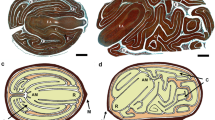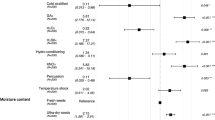Abstract
MONOCARPY, a single flowering phase followed by senescence and death, is a widespread phenomenon in seed plants, particularly field crops, whose large monocultures put on a dramatic display during their senescence phase1–4. In many, but apparently not all monocarpic species, defruiting or deflowering ,can prevent or at least delay monocarpic senescence and death1–4. For some species such as soybeans, the killing influence has been traced to the developing seeds5. The conspicuous correlation between the accumulation of nutrients in the developing fruit and the senescence (or apparent ‘exhaustion’) of the leaves (Fig. 1) has led to the sugegstion that developing fruits cause senescence by diverting or withdrawing needed nutrients or hormones from the leaves and other vegetative parts1–4. Here we explore the relationship between nutrient (or hormone) withdrawal or diversion and foliar senescence. Our data indicate that the development (accumulation of dry matter) of the seeds is separable from the senescence response in soybeans, and therefore the seeds may function as more than sinks.
This is a preview of subscription content, access via your institution
Access options
Subscribe to this journal
Receive 51 print issues and online access
$199.00 per year
only $3.90 per issue
Buy this article
- Purchase on Springer Link
- Instant access to full article PDF
Prices may be subject to local taxes which are calculated during checkout
Similar content being viewed by others
References
Molisch, H. Die Lebensdauer der Pflanze. (G. Fischer, Jena, 1928); (transl. Fulling, E. H.) (Science Press, Lancaster, Pennsylvania, 1938).
Leopold, A. C., Niedergang-Kamien, E. & Janick, J. Plant Physiol. 34, 570–573 (1959).
Wangermann, E. in Handbuch der Pflanzenphysiologie 15(2) (ed. Ruhland, W.) 1037–1057 (Springer, Berlin, 1965).
Noodén, L. D. & Leopold, A. C., in Plant Hormones and Related Compounds (eds Letham, D. S., Higgins, T. J. & Goodwin, P. B.) (Elsevier, Amsterdam, in the press).
Lindoo, S. J. & Noodén, L. D. Plant Physiol 59, 1136–1140 (1977).
Lindoo, S. J. & Noodén, L. D. Bot. Gaz. Chicago 137, 218–223 (1976).
Borthwick, H. A. & Parker, M. W. Bot. Gaz. Chicago 100, 374–387 (1938).
Dawson, R. M., Elliot, D. C., Elliot, M. H. & Jones, K. M. Data for Biochemical Research, 2nd edn (Clarendon, Oxford, 1969).
Middleton, K. R. J. appl. Chem. 10, 281–286 (1960).
Thrower, S. L. Aust. J. biol. Sci. 15, 629–649 (1962).
Thrower, S. L. Symp. Soc. exp. Biol. 21, 483–506 (1967).
Krizek, D. T., McIlrath, W. J. & Vergara, B. S. Science 151, 95–96 (1966).
Author information
Authors and Affiliations
Rights and permissions
About this article
Cite this article
NOODEN, L., RUPP, D. & DERMAN, B. Separation of seed development from monocarpic senescence in soybeans. Nature 271, 354–357 (1978). https://doi.org/10.1038/271354a0
Received:
Accepted:
Published:
Issue Date:
DOI: https://doi.org/10.1038/271354a0
This article is cited by
-
Impact of girdling and leaf removal on Alhagi sparsifolia leaf senescence
Plant Growth Regulation (2016)
-
Relationship of developing pods with photosynthetic characteristics of leaves in chick pea
Proceedings / Indian Academy of Sciences (1985)
-
Soybean leaf photosynthesis in relation to maturity classification and stage of growth
Photosynthesis Research (1982)
Comments
By submitting a comment you agree to abide by our Terms and Community Guidelines. If you find something abusive or that does not comply with our terms or guidelines please flag it as inappropriate.



